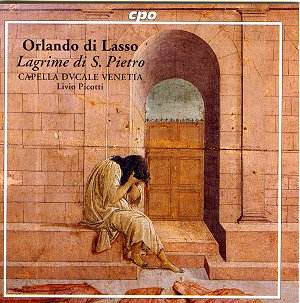Orlandus Lassus was the most famous composer
of the second half of the 16th century. The publication of the
‘Lagrime di San Pietro’ is a testimony of his fame. It is a splendid
edition, prepared with utmost care by Adam Berg in Munich, who
had published Lassus’s works since 1567.
Lassus himself never saw the edition. It appeared
in 1595, one year after his death. The last five years of his
life were difficult. From 1587 onwards he suffered from melancholia
and hallucinations. Shortly before his death he was able to compose
again, and he decided to select twenty sacred madrigals from the
collection ‘Lagrime di San Pietro’ by the Italian poet Luigi Tansillo
(1510 – 1568), which contained forty-two stanzas of eight lines
(‘ottave rime’) on the grief and the repentance of St Peter after
his denial of Christ. To these twenty madrigals Lassus added a
Latin motet.
The images used in secular poetry were often
used in sacred poetry as well. The love for a lady was transferred
to the relationship between the believer and Mary or Jesus. The
‘Lagrime’ is no exception. It contains elements which also appear
in secular poetry of the time.
The ‘Lagrime’ doesn’t describe the events at
the cross, but the feelings of St Peter about what is going on,
and in particular his role in it. Lassus’s music is following
the text very closely, making use of the madrigalisms which were
in vogue.
There is also strong symbolism in the settings
by Lassus. This symbolism turns around the numbers seven – all
madrigals are set for seven voices - and three – the cycle is
divided into three sections. The whole cycle contains twenty-one
items; three times seven. The number seven is associated with
sorrow and sin, the number three here refers to the number of
times St Peter denied Christ.
There are different theories regarding the reasons
why Lassus composed this work. Some believe that, since Lassus
felt his end was near, he thought it necessary to do penance for
his sins – for instance, his composition of secular works on morally
dubious texts – and a composition like this was the best way to
do so. Whether this is true or not, this work certainly had a
personal meaning for Lassus, as in the dedication he called it
"a personal devotion at this difficult age".
In his liner notes, Marco Gemmani states, "In
a highly critical environment, such as Germany was during this
period, the ‘Lagrime’ represents Orlando di Lasso’s ultimate effort
to bring about the reconciliation of the Catholic world and the
Protestant world, two worlds which at the time were moving farther
and farther apart." But he doesn’t give any evidence to support
this assumption. In fact, Lassus dedicated the work to the pope,
Clemens VIII, with these words: "I hope that you will take
pleasure in listening to my music, not for itself, but for the
subject of which it speaks, Saint Peter, the foremost among the
apostles of whom you are the true and lawful successor."
How could this help to reconcile Catholics and Protestants?
The ‘Lagrime di San Pietro’ has been recorded
a number of times before. Generally speaking there are two kinds
of interpretation: a cappella or with voices and instruments.
Although the practice at the Bavarian court where Lassus worked
certainly suggests a frequent use of instruments, one could argue
that because of the intimate character of these sacred madrigals
an ‘a cappella’ performance is most suitable.
Livio Picotti has chosen the second option, though.
Alongside the seven singers he uses two tenor recorders, two tenor
viols, two bass viols, bassoon and organ, which play strictly
‘colla parte’.
Marco Gemmani writes: "The practice employed
here, that of refraining from cheap coloristic exaggerations,
enables it to reveal the strong mystical character pervading the
whole of the work." This is an honourable approach, but does
that imply a performance with very little expression of the text?
That is what is the problem here. The text is very hard to understand:
the singers don’t articulate very well. Furthermore, the voices
are rather dark-coloured and the addition of instruments doesn’t
make it easier to follow the text. The tempi are pretty straightforward,
without much differentation on the basis of the text.
Another matter is the fact that two groups of
three madrigals (13 – 15 and 19 – 21) are notated in ‘chiavette’.
The general view is that in cases like this the composer intends
a transposition downwards. This practice has been ignored here.
I am not very satisfied with this performance.
If one prefers an interpretation with voices and instruments,
the recording by Paul Van Nevel’s Huelgas Ensemble (Sony) is first
choice. I personally prefer an a cappella performance; here I
recommend the recording by the Ensemble vocal européen,
directed by Philippe Herreweghe (Harmonia Mundi).
Johan van Veen


